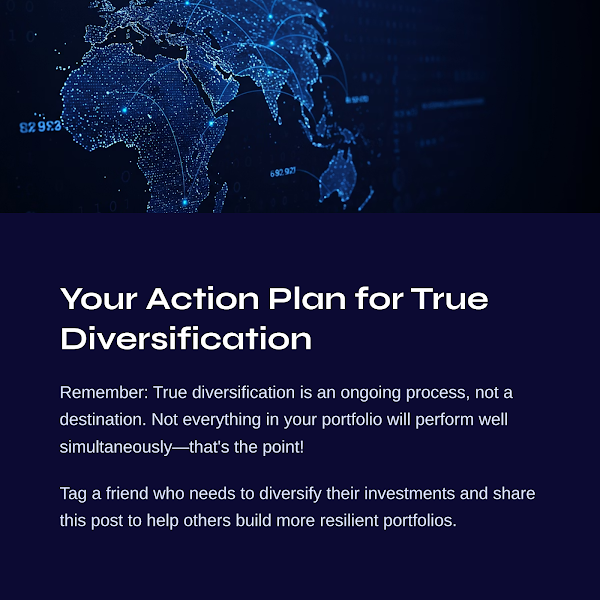You’re Not Diversified—You’re Delusional
Hello~ Everyone, Today I'm talking about portfolio diversification and why many of us might be fooling ourselves! I have some useful information for you guys~ Shall we find out right away?
When it comes to investing, we often hear the phrase "don't put all your eggs in one basket." But are we really diversifying our investments properly, or are we just deluding ourselves into thinking we're safe?
Many investors believe they're diversified because they own a handful of different stocks or a couple of ETFs. But true diversification goes far beyond that!
Proper diversification isn't just about quantity—it's about quality and correlation. You could own 20 different tech stocks and still be dangerously undiversified.
What matters most is how your assets move in relation to each other. If everything in your portfolio goes down when the market dips, you're not really diversified at all.
Let's look at some common diversification mistakes:
| Mistake | Real-World Example |
| Owning multiple similar ETFs | Holding VOO, SPY, and IVV (all S&P 500 funds) |
| Industry concentration | Owning Apple, Microsoft, Google, and Amazon thinking you're diversified |
| Ignoring geographic diversification | Having 95% of investments in your home country |
| Only focusing on one asset class | Investing solely in stocks with no bonds, real estate, or alternatives |
One of the biggest diversification delusions is ignoring correlation. Correlation measures how investments move in relation to each other.
Did you know that during market crashes, correlations between different stocks tend to increase? This means your supposedly "diverse" stock portfolio may all crash together!
Even traditional hedges like gold and bonds don't always work as expected during extreme market events.
The key is to look for assets with low or negative correlation to each other. This way, when one part of your portfolio is struggling, another might be thriving.
True diversification means expanding beyond just stocks. Have you considered these other asset classes?
Real estate can provide both income and appreciation, often moving differently from stock markets. REITs make it easy to add real estate exposure without buying property.
Bonds still serve an important role despite low yields. They can provide stability when stocks plummet, especially high-quality government bonds.
Alternative investments like commodities, private equity, or even a small allocation to cryptocurrencies can further diversify your portfolio.
Remember, the goal isn't just to own different things—it's to own things that respond differently to economic events!
How can you tell if you're truly diversified? There are several metrics you should examine:
Portfolio beta measures your overall market sensitivity. A beta of 1.0 means you move exactly with the market.
Sharpe ratio helps determine if your diversification is actually improving your risk-adjusted returns.
Looking at maximum drawdown can reveal how your portfolio might perform in worst-case scenarios.
Don't just look at your investment performance during bull markets—that's when everything goes up. The true test comes during market corrections and crashes!
| Asset Class | Role in Portfolio | Risk Level |
| US Large Cap | Growth engine | Medium-High |
| International Stocks | Geographic diversification | High |
| Government Bonds | Stability/Safety | Low |
| Corporate Bonds | Income generation | Medium |
| REITs | Inflation hedge/Income | Medium-High |
| Commodities | Inflation hedge | High |
| Cash | Safety/Opportunity fund | Very Low |
| Small Cap | Growth potential | High |
| Emerging Markets | Long-term growth | Very High |
| TIPS | Inflation protection | Low |
| High Yield Bonds | Income boost | Medium-High |
| Alternatives | Correlation reduction | Variable |
In today's interconnected global economy, geographic diversification is more important than ever. But it's also getting harder to achieve!
Many US investors suffer from home country bias—investing too heavily in familiar domestic companies while ignoring international opportunities.
Did you know that the US stock market represents less than 60% of the global market capitalization? By ignoring international stocks, you're missing out on huge segments of the global economy.
Emerging markets offer higher growth potential, though with additional risks. Developed international markets can provide stability with different economic cycles than the US.
Remember that currency exposure is part of international diversification too—sometimes currency movements can be as important as the underlying investment performance!
Let's address some common questions about portfolio diversification:
| How many stocks do I need to be diversified? | Research suggests at least 20-30 individual stocks across different sectors provides sufficient diversification of company-specific risk. However, owning a broad market index fund is often simpler and more effective. |
| Does diversification reduce returns? | Proper diversification aims to optimize risk-adjusted returns, not maximize absolute returns. While a concentrated portfolio might outperform in certain periods, it carries substantially higher risk of catastrophic losses. |
| How often should I rebalance my diversified portfolio? | Most financial advisors recommend reviewing asset allocation quarterly and rebalancing at least annually, or when allocations drift significantly (usually 5-10%) from your targets. |
The truth is that proper diversification isn't always exciting—and that's the point! A truly diversified portfolio will always have some components that aren't performing well. If everything is going up at once, be suspicious.
Remember that diversification is not a one-time task but an ongoing process. As market conditions change and your life circumstances evolve, your diversification strategy should adapt as well.
See you next time with another interesting financial topic! 👋 Bye Bye~





Comments
Post a Comment